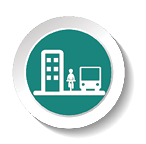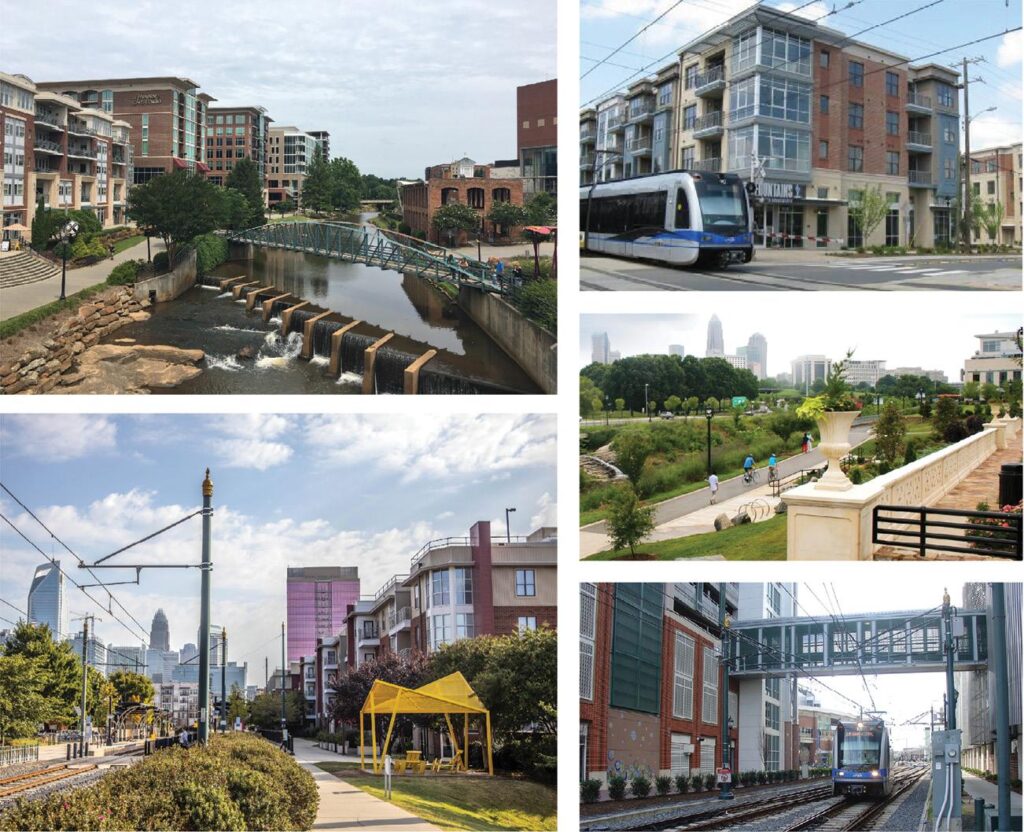Home / 03. Policy Framework / Goal 4: Transit- and Trail-Oriented Development (2T-OD)
Plan Policy
Table of contents
Goal 4: Transit- and Trail-Oriented Development (2T-OD)

Goal 4: Transit- and Trail-Oriented Development (2T-OD)

Charlotte will promote moderate to high-intensity, compact, mixed-use urban development along high-performance transit lines and near separated shared-use paths or trails.

Objectives
- Increase the percentage of households and jobs (new and existing) within ½ mile access to trail access points.
- Increase the share of households and jobs with safe access to high-performance transit stations (light rail, streetcar, bus rapid transit, and bus routes with headways of 15 min or less during peak hours).
- Increase the share of commercial (mixed use, entertainment, and employment) development within a 10-minute tree-shaded walk or bike trip of trail access points and high-performance transit stations.
- Approach maximum build out under the TOD zoning for development within a 10- minute walk or bike trip of trail access points and high-performance transit stations.
- Increase the number of moderate- to high-intensity developments along regional transit and trail routes.
- Increase safe and connected bike infrastructure within two miles of transit stops and trail access points.
- Decrease the percentage of transit stops without access to sidewalks.
- Provide signalized pedestrian crossings at all transit stops on thoroughfares.
- Increase the number of connections between new trail and/or transit line developments and neighborhoods of varying land uses, densities, and architecture.
- Increase the number of developments that are transit-oriented in both location
and design. - Create engaging public spaces near high-performance transit stops, stations
and trails.
Big Policy Ideas
- Prioritize equitable TOD (E-TOD) along high-performance transit and trail corridors.
- Continue to ensure TOD zoning matches characteristics of Activity Centers as discussed in the Plan (applies to Regional Activity Center, Community Activity Center, Neighborhood Center, and Campus).
- Encourage active transportation, connectivity, and multimodal access through updates to the development regulations, active transportation design standards, and mobility investment prioritization processes as outlined in the Strategic Mobility Plan and Goal #5. (cross-reference: Goal 5, Goal 6)
- For new high-performance transit corridors, apply TOD zoning that facilitates market-supported transit-oriented developments served by local transit services and shared-use paths in a context-sensitive design that reflect individual corridor opportunities as guided by the Strategic Mobility Plan and Future Place Types Map.
- Near high-performance transit stations, apply TOD zoning which does not require minimum parking and has parking maximums. (cross-reference: Goal 5)
- Support application of innovative parking management strategies and technologies to meet parking requirements.
- Locate parking behind or beside buildings and consolidate into shared areas to optimize pedestrian environment along main streets.
- Explore the feasibility of implementing shared parking/parking district programs, especially in higher density areas with a mix of uses. (cross-reference: Goal 1, Goal 3)
- Consider multimodal transportation impacts in the development approval process, with a focus on transportation investment priorities.
- Investigate use of shared parking at park-and-ride mobility hubs to facilitate access to higher intensity Activity Centers with more limited parking.
- Encourage new developments to locate along shared-use paths outside environmentally sensitive areas, and to create public gathering spaces along the shared-use paths, allowing development to have direct access to or front the shared use.
- Evaluate the existing Environmental Bonus Menu items in the TOD zoning ordinance to understand their use and efficacy over time to support our low carbon city goals; update the Bonus Menu as necessary for TOD and other zoning districts.
As cities and neighborhoods continue to grow, the implementation of Trail-Oriented Developments has proven effective in connecting and strengthening communities. A recent publication by the Urban Land Institute summarizes the success of Trail-Oriented Development, and the use of investment in bicycle and pedestrian infrastructure to catalyze high-quality development. Many cities have experienced a boost to their economic growth based on improved real estate value and an increase in retail visibility. Cities are supporting Trail-Oriented Development with programs that build multi-use paths, and zoning that supports mixed-use land uses near trails.
- Support CATS System Plan update vision statements: 1) establish reliable transit to connect the region, enhance quality of life, and strengthen access to opportunities, 2) use transit to influence and shape growth while respecting community character, and 3) increase mobility in each corridor through effective transit investments.
- Establish a mobility investment priority hierarchy within high-performance transit station areas that assigns priority to pedestrians/transit riders, cyclists/shared-mobility users, delivery/loading needs, and finally, private motor vehicles, in that order, when making mobility investments and designing transportation facilities including streets.
- Prioritize shared-use path development to connect to existing neighborhoods, fill gaps in the existing multimodal network with all ages-and-abilities facilities and connect to new higher intensity developments as identified in the Strategic Mobility Plan. (cross-reference: Goal 4. Goal 6)
- Support investment in utilities and multipurpose facilities (e.g. greenways provide recreation opportunities, transportation connections, and stormwater benefits) in urban areas and established neighborhoods through coordinated efforts with County Park and Recreation, CDOT, Storm Water Services, and other partners. (cross-reference: Goal 4, Goal 6)
- Investigate use of micromobility solutions (bike-share, scooter-share, etc.) to address intra-neighborhood circulation concerns.
- Ensure all 2T-OD development prioritizes tree-shaded and safe sidewalks, trails, and bike routes using trees to maximize comfort and safety.
- Locate high-performance transit stations to maximize accessibility to neighborhoods with low-income households while avoiding direct displacement of existing residents.
- In coordination with regional and local partners including Charlotte Regional Transportation Planning Organization (CRTPO), North Carolina Department of Transportation (NCDOT), South Carolina Department of Transportation (SCDOT), Charlotte Area Transit System (CATS), and major employers, support transportation demand management (TDM) strategies that recognize the value of parking management, walk and bike facilities, and transit service. (cross-reference: Goal 5, Goal 8)
- Improve inter-departmental and inter-jurisdictional cooperation in planning, implementing, and maintaining shared-use path facilities. (cross-reference: Goal 5)
- Improve coordination of transit alignment planning with land-use planning to maximize effectiveness of transit investments by using future Place Types mapping to inform transit planning efforts.
- Coordinate with Business Districts (such as Business Improvement Districts), Municipal Service Districts and other area organizations on local transportation projects and leverage resources as available.
- Encourage public-private partnerships for creation of high-quality public spaces integrated with new development within high-performance transit station areas.
Recommended Projects
- Assess development regulation standards related to connectivity, block length, and transportation cross-sections and update for consistency with Plan policies.
- Identify programs and regulations to encourage developers to approach the maximum allowable density for development near trail access points and high-performance transit.
- Work with partners to develop transportation demand management (TDM) strategies that support plan goals.
- Develop a scorecard system for prioritizing in the Capital Improvement Plan (CIP) bicycle, pedestrian, and other active mode capital improvements for low-income communities that have limited accessibility and connectivity.
- Work with regional partners to develop a coordinated implementation phasing plan for regional trail corridors like the Cross Charlotte Trail, the Mooresville to Charlotte Trail, and the Silver Line Rail Trail.
- Identify and address safety issues and barriers to access to existing high-performance transit stops. Add publicly accessible streets, alleys, and through-block passages to improve pedestrian connections when possible.
- Work with CATS and Housing, Neighborhood Services, and other local and regional partners to leverage park and ride locations, as well as surplus parking to provide equitable TOD opportunities.

Image source: https://www.shutterstock.com/search/traffic+downtown+chicago
Equitable TOD (E-TOD) is development that enables all people regardless of income, race, ethnicity, age, gender, immigration status or ability to experience the benefits of dense, mixed-use, pedestrian-oriented development near transit hubs. E-TOD elevates and prioritizes investments and policies that close the socioeconomic gaps between neighborhoods that are predominately people of color and those that are majority white. E-TOD projects also help to ensure that the people and households who most need transit access are not priced out of station areas or transit corridors.
Since 2013, the City of Chicago has been encouraging compact, mixed-use transit-oriented development (TOD) near CTA and Metra rail stations. This development model can create additional benefits to the community such as increased transit ridership and more walkable communities, both of which reduce traffic congestion and greenhouse gas emissions, while also promoting public health and adding to the City’s tax base. A January 2019 TOD ordinance amendment included an explicit equity focus and expanded TOD policy provisions to include property near several high-frequency bus corridors as well as extended the incentives to the densest residential zones. The 2019 Ordinance also requires the City to evaluate the performance of recent TOD projects and recommend revisions to the TOD provisions where appropriate. The City’s 2020 E-TOD Policy Plan is further advancing equitable TOD development in Chicago by:
- Leveraging publicly owned land and vacant lots near transit for public benefit;
- Preserving unsubsidized affordable housing in TOD zones;
- Strengthening affordability and accessibility requirements;
- Developing incentives and policies to preserve and retain community organizations, small businesses and other neighborhood assets in TOD zones; and
- Prioritizing E-TOD in applications with city funding.
